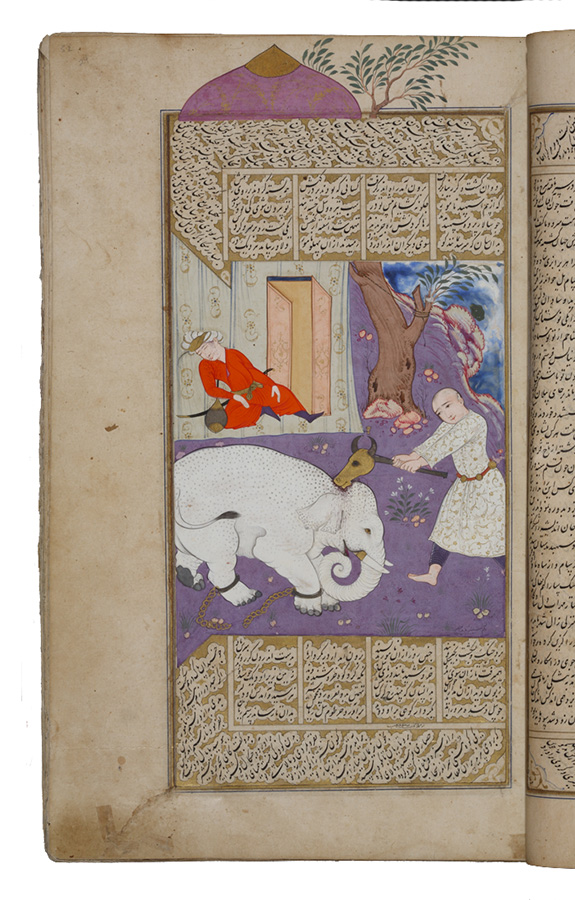Manuscript B, no. 1-328 (David folio 32a)
Rostam Kills the White Elephant
Location: The David Collection, Copenhagen, Denmark, #217/2006, folio 32a.
Page: 35.2 x 21.8 cm.
Painting: 18.4 x 14.0 cm. (Scaled) without extension into the top margin
Text area: 28.7 x 14.0 cm. (Scaled)
Signature: in the lower right corner of the painting: raqam-e kamina moʿin-e moṣavver.
As a boy, Rostam and his father Zāl traveled to Sistan. After a night of revelry Rostam was awakened from his sleep by people shouting that the local chief's white elephant had broken loose and was on a rampage. Armed with his grandfather Sam's mace, Rostam went forth to confront the beast, but the gatekeeper attempted to stop him. Rostam responded by striking the gatekeeper on the head, smashing his way through the gate, and felling the elephant with a mighty blow to the head. In the painting, Rostam, dressed in his nightclothes and without turban or shoes, has just landed his mace on the elephant's head, as the gatekeeper lies bleeding next to the open gate.
Moʿin has retained the palette of purple, red, and violet here while adding another trademark element, the stormy sky with clouds depicted in his characteristic watercolor technique. Moreover, the sagging flesh of the elephant's legs and belly anticipates Moʿin's later animal drawings. The twisting bark of the tree also will appear often in Moʿin's manuscript illustrations. While the text of the Shahnama implies that Rostam emerged from a walled palace or city to combat the elephant, Moʿin has depicted a yurt-shaped tent with its dome extending into the upper margin and one of its ropes attached to the tree.
Illustrations of this popular episode are found in 17th-century Shahnamas, including the mid-century manuscript in the Golestan Palace Library. There the artist has emphasized the rage of the elephant and has included several figures that it has trampled. Most other Safavid renderings of this scene include numerous figures and a detailed architectural setting. By contrast, Moʿin has limited the figures to two men and the elephant, and has chosen to illustrate the minute after Rustam has subdued the elephant. The prototype for this composition may thus be an illustration of Ḵosrow defeating the lion from the Khamsa of Nezami rather than a Shahnama image (fn.31).
Painting references:
Canby_ Journal_2010, p.62-63 no.4 and p.86, fig.18.
Text references:
Warner, I, pp.327-30.
Photo: Permille Klemp. Courtesy of The David Collection, Copenhagen
Sheila R. Canby
Last Updated: January 5, 2014 | Originally published: 2010
